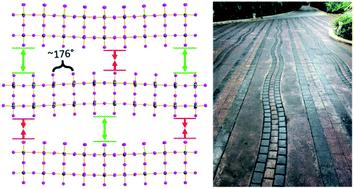当前位置:
X-MOL 学术
›
Chem. Sci.
›
论文详情
Our official English website, www.x-mol.net, welcomes your
feedback! (Note: you will need to create a separate account there.)
Long periodic ripple in a 2D hybrid halide perovskite structure using branched organic spacers
Chemical Science ( IF 7.6 ) Pub Date : 2020-10-06 , DOI: 10.1039/d0sc04144k Justin M Hoffman 1 , Christos D Malliakas 1 , Siraj Sidhik 2 , Ido Hadar 1 , Rebecca McClain 1 , Aditya D Mohite 2 , Mercouri G Kanatzidis 1
Chemical Science ( IF 7.6 ) Pub Date : 2020-10-06 , DOI: 10.1039/d0sc04144k Justin M Hoffman 1 , Christos D Malliakas 1 , Siraj Sidhik 2 , Ido Hadar 1 , Rebecca McClain 1 , Aditya D Mohite 2 , Mercouri G Kanatzidis 1
Affiliation

|
Two-dimensional (2D) halide perovskites have great promise in optoelectronic devices because of their stability and optical tunability, but the subtle effects on the inorganic layer when modifying the organic spacer remain unclear. Here, we introduce two homologous series of Ruddlesden–Popper (RP) structures using the branched isobutylammonium (IBA) and isoamylammonium (IAA) cations with the general formula (RA)2(MA)n−1PbnI3n+1 (RA = IBA, IAA; MA = methylammonium n = 1–4). Surprisingly, the IAA n = 2 member results in the first modulated 2D perovskite structure with a ripple with a periodicity of 50.6 Å occurring in the inorganic slab diagonally to the [101] direction of the basic unit cell. This leads to an increase of Pb–I–Pb angles along the direction of the wave. Generally, both series show larger in-plane bond angles resulting from the additional bulkiness of the spacers compensating for the MA's small size. Larger bond angles have been shown to decrease the bandgap which is seen here with the bulkier IBA leading to both larger in-plane angles and lower bandgaps except for n = 2, in which the modulated structure has a lower bandgap because of its larger Pb–I–Pb angles. Photo-response was tested for the n = 4 compounds and confirmed, signaling their potential use in solar cell devices. We made films using an MACl additive which showed good crystallinity and preferred orientation according to grazing-incidence wide-angle scattering (GIWAXS). As exemplar, the two n = 4 samples were employed in devices with champion efficiencies of 8.22% and 7.32% for IBA and IAA, respectively.
中文翻译:

使用支化有机间隔基的二维杂化卤化物钙钛矿结构中的长周期波纹
二维(2D)卤化物钙钛矿因其稳定性和光学可调性而在光电器件中具有广阔的前景,但修饰有机间隔物时对无机层的微妙影响仍不清楚。在这里,我们引入了两个同系系列的 Ruddlesden-Popper (RP) 结构,使用支链异丁基铵 (IBA) 和异淀粉铵 (IAA) 阳离子,通式为 (RA) 2 (MA) n -1 Pb n I 3 n +1 ( RA = IBA、IAA;MA = 甲基铵n = 1–4)。令人惊讶的是,IAA n = 2 成员产生了第一个调制的 2D 钙钛矿结构,其周期性为 50.6 Å 的波纹出现在无机板中,与基本晶胞的 [101] 方向呈对角线。这导致 Pb-I-Pb 角度沿波的方向增加。一般来说,这两个系列都显示出较大的面内键合角,这是由于间隔物的额外体积补偿了 MA 的小尺寸。较大的键角已被证明可以减小带隙,此处可以看到,较大的 IBA 导致较大的面内角和较低的带隙,但n = 2 除外,其中调制结构由于其较大的 Pb– 而具有较低的带隙I-Pb 角。对n = 4 种化合物的光响应进行了测试并得到证实,表明它们在太阳能电池设备中的潜在用途。我们使用 MACl 添加剂制作薄膜,根据掠入射广角散射 (GIWAXS),该添加剂显示出良好的结晶度和择优取向。 作为示例,两个n = 4 样本应用于 IBA 和 IAA 的冠军效率分别为 8.22% 和 7.32% 的设备中。
更新日期:2020-10-17
中文翻译:

使用支化有机间隔基的二维杂化卤化物钙钛矿结构中的长周期波纹
二维(2D)卤化物钙钛矿因其稳定性和光学可调性而在光电器件中具有广阔的前景,但修饰有机间隔物时对无机层的微妙影响仍不清楚。在这里,我们引入了两个同系系列的 Ruddlesden-Popper (RP) 结构,使用支链异丁基铵 (IBA) 和异淀粉铵 (IAA) 阳离子,通式为 (RA) 2 (MA) n -1 Pb n I 3 n +1 ( RA = IBA、IAA;MA = 甲基铵n = 1–4)。令人惊讶的是,IAA n = 2 成员产生了第一个调制的 2D 钙钛矿结构,其周期性为 50.6 Å 的波纹出现在无机板中,与基本晶胞的 [101] 方向呈对角线。这导致 Pb-I-Pb 角度沿波的方向增加。一般来说,这两个系列都显示出较大的面内键合角,这是由于间隔物的额外体积补偿了 MA 的小尺寸。较大的键角已被证明可以减小带隙,此处可以看到,较大的 IBA 导致较大的面内角和较低的带隙,但n = 2 除外,其中调制结构由于其较大的 Pb– 而具有较低的带隙I-Pb 角。对n = 4 种化合物的光响应进行了测试并得到证实,表明它们在太阳能电池设备中的潜在用途。我们使用 MACl 添加剂制作薄膜,根据掠入射广角散射 (GIWAXS),该添加剂显示出良好的结晶度和择优取向。 作为示例,两个n = 4 样本应用于 IBA 和 IAA 的冠军效率分别为 8.22% 和 7.32% 的设备中。











































 京公网安备 11010802027423号
京公网安备 11010802027423号